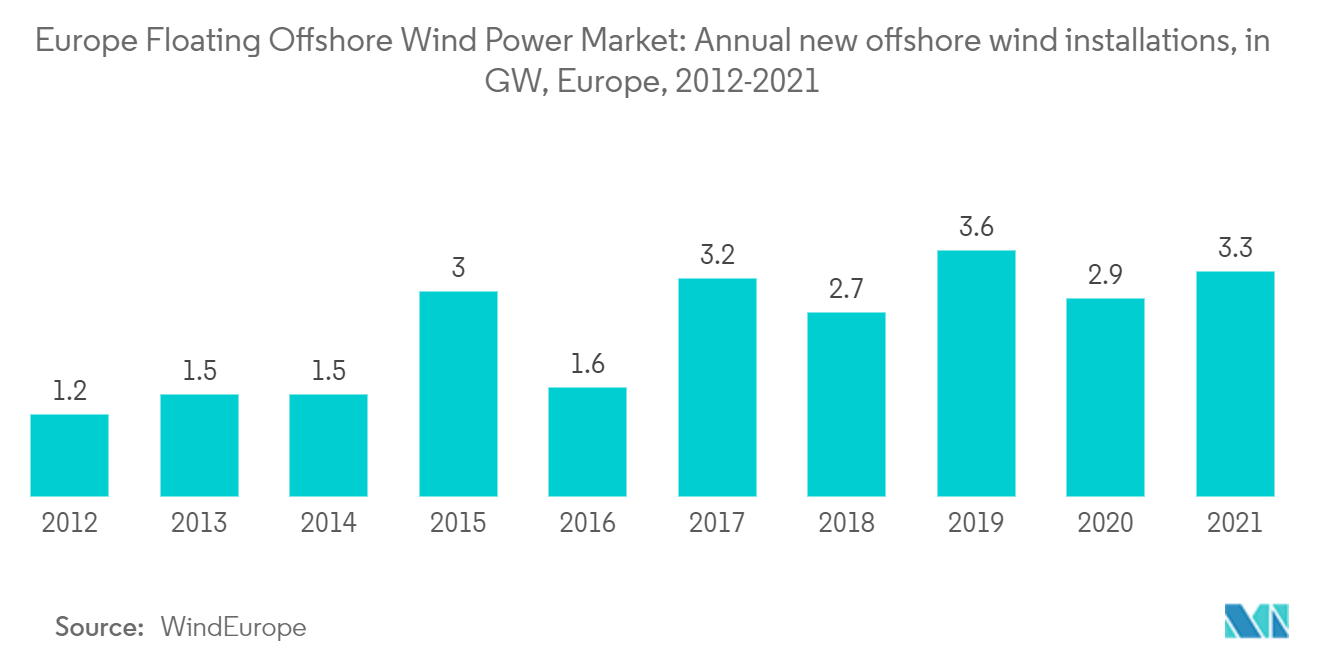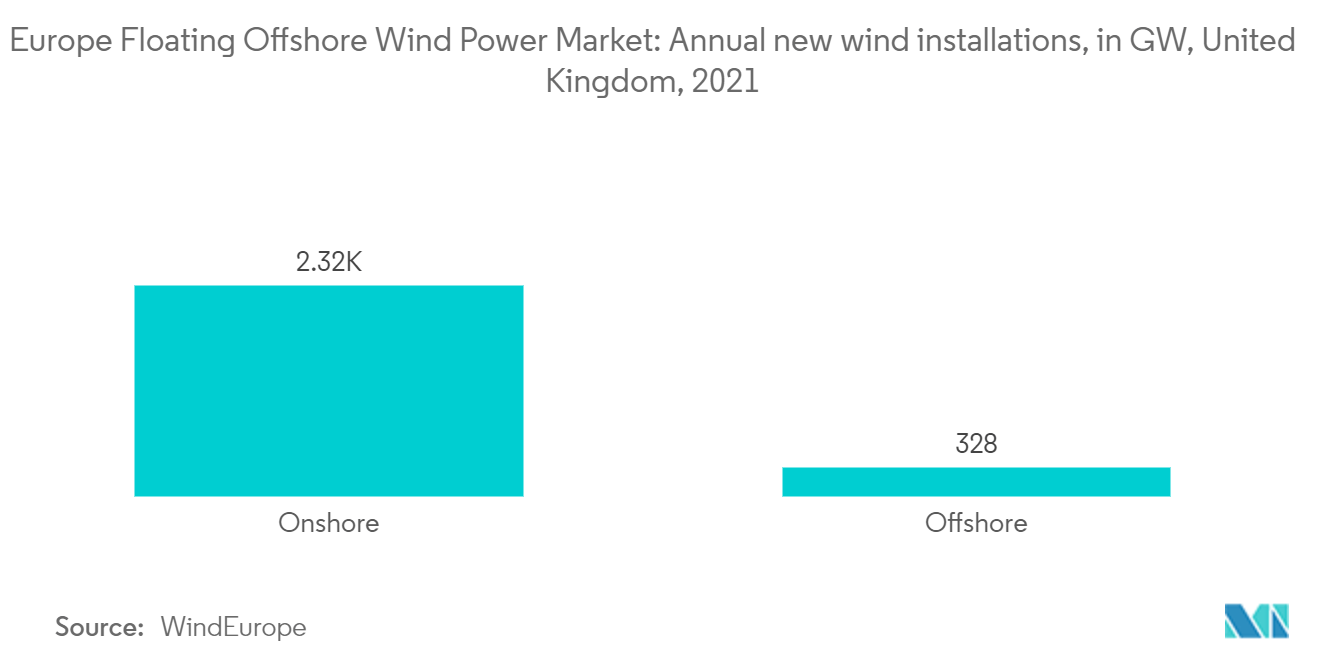Market Trends of Europe Floating Offshore Wind Power Industry
This section covers the major market trends shaping the Europe Floating Offshore Wind Power Market according to our research experts:
Government Policies and Private Investments in Floating Offshore Wind Power
Offshore wind is seen as a key new industry offering a potential transition for Norway's dominant oil and gas sector to a renewable energy future. In December 2020, the Norwegian Minister of Petroleum and Energy announced a new wind power research center in Norway. The NorthWind research center will focus on innovations, and one of its main priorities will be offshore wind power research.
However, Norway has faced local opposition to onshore wind power projects based on the perceived impact on landscapes and ecology. Accordingly, in May 2022, Norway unveiled plans for a major expansion in offshore wind energy by 2040, aiming to turn a country that has built its wealth on oil and gas into an exporter of renewable electricity. The government, which has come under fire from environmentalists for continuing to support the oil and gas industry, set a target to develop 30 gigawatts (GW) of offshore wind capacity by 2040.
Several companies are already lining up to participate in Norway's effort, looking to expand their own offshore wind ambitions and showcase new technology that draws on the experience with the oil and gas exploration industry.
For instance, Shell and BP are among the companies with an interest in Norwegian installations, along with Eni, Equinor, and Orsted. Vattenfall and Norway's Seagust also announced that they had formed a joint venture to bid in the auction. EDF Renewables declared that it had partnered with Deep Wind Offshore, a Norwegian independent power producer, to participate in the process in December 2021.
The floating offshore wind power market in France is one of the largest in the world. The country also showcased its interest to install 50 offshore wind farms by 2050, with a total capacity of 40 GW, and to slow down the development of onshore wind power. As part of the process of increasing the offshore wind capacity, the government of France launched the competitive tendering procedure for the development of two 250 MW floating offshore wind farms in the Mediterranean Seain in March 2022. The first wind farm will be located off Narbonne, more than 22 km from the coast, while the second wind farm is located 22 km off Fos-sur-Mer, subject to the results of ongoing environmental studies.
According to Wind Energy Ireland's (WEI) most recent developer survey carried out in Q1 2021, there are approximately 3 GW of floating offshore wind energy projects in the early stages of development in the Celtic Sea. An additional 5 GW of floating offshore wind energy projects are proposed for the Atlantic. For instance, in June 2022, the Killybegs Fishermen's Organization and Sinbad Marine Services proposed a floating wind farm to be built offshore Donegal, Ireland. They signed a Memorandum of Understanding with Swedish floating wind developer and technology provider, Hexicon.
As of 2021, there were 17.4 GW of new wind installations in Europe, with 14 GW onshore and 3.4 GW offshore. As 2021 marks a record year for wind installations (surpassing 2017's 17.1 GW figure), the EU-27 will need to install 32 GW of wind capacity each year in order to achieve the 40% renewable energy target.
With great access to offshore wind resources in the region and support from the various country governments, Europe is anticipated to be one of the biggest markets for floating offshore wind energy during the forecast period.

United Kingdom to Dominate the Market Growth
The United Kingdom is one of the world's largest markets for offshore wind power, with more than 10 GW of cumulative installed capacity across 38 sites as of 2021. There is a further 5 GW in pre-construction, and there are plans for a further 11 GW.
According to WindEurope, in 2021, the United Kingdom had 2.6 GW of offshore installations, accounting for 88% of Europe's offshore installations. The completion of the Moray East and Triton Knoll wind farms primarily drove offshore installations. Despite a slight increase in onshore installations in the United Kingdom, they remain the second lowest since 2005.
The growth of the sector was encouraged by the United Kingdom's target of 40 GW of offshore wind energy by 2030, as stated in the Ten Point Plan for a Green Industrial Revolution. This includes 1 GW generated by floating technologies. This ambition was increased through the British Energy Security Strategy (BESS), published in April 2022, which aims to achieve up to 50 GW of offshore wind by 2030, of which floating offshore wind would contribute 5 GW.
As part of the plan to net zero, the Scottish government has set a target to deliver up to 11 GW of offshore wind capacity by 2030 to support Scotland's commitment to net zero emissions by 2045. Scotland is home to the world's first commercial floating offshore wind project, Equinor/Masdar's Hywind Scotland wind farm, which used 5 SGRE 6 MW turbines, commissioned in 2017.
In August 2022, Cerulean Winds and Ping Petroleum UK signed an agreement on offshore oil and gas facilities powered mainly by offshore wind. Under the agreement, Cerulean Winds, with its consortium of Tier 1 industrial partners, will provide a large floating offshore wind turbine that will be connected via a cable to Ping Petroleum's Floating Production & Storage vessel. The project is expected to come online in 2025. The project was enabled by a grant to Cerulean Winds through the Floating Offshore Wind Demonstration Program.
Therefore, with the help of the UK government and its ambitious plans for the offshore wind segment, the United Kingdom is predicted to be a dominant country in the floating offshore wind power market worldwide.


